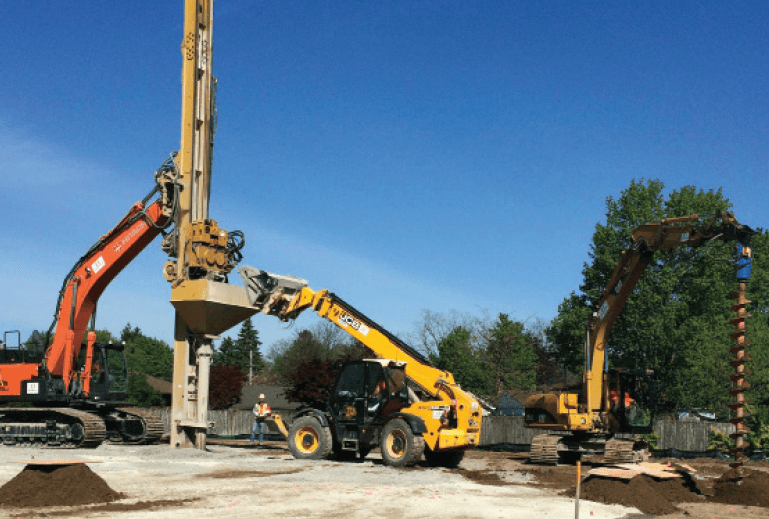
Ground improvement techniques have become more widely used in Canada over the past decade and owners, developers, contractors and engineers have gradually taken notice of the unique advantages offered by using ground improvement techniques. Of the many ground improvement techniques used in Canada, few have been employed more often than the Geopier Rammed Aggregate Pier® (RAP) system.
Since 2006, many thousands of linear kilometres of Geopier RAP elements have been installed in Canada to support industrial, commercial and residential projects, and other applications such as liquefaction mitigation, embankment and wall support, and other structures. Since its introduction in the U.S. over 30 years ago, the Geopier RAP system reinforces a wide variety of soil types including undocumented fill, loose sands, soft/sensitive clays, silts and trapped organics to provide increased bearing capacity and engineered settlement control.
RAP systems have been used worldwide since the early 1990s. “Stone columns,” now branded as “aggregate piers” or “vibro stone columns,” were first developed in Germany to densify loose sand soils using a horizontally vibrating probe with surface fed aggregate.
The precision RAP system called Geopier® was developed by the Geopier Foundation Company to provide an efficient intermediate foundation solution for the support of settlement sensitive structures in more difficult soil conditions. These systems were originally developed as an alternative to excavation and replacement in more cohesive soils. Due to its unique construction method, Geopier RAP elements provide greater capacity than stone columns – particularly in non-sand soil conditions (clay, silt, organic containing and fill soils).
Both Geopier RAP elements and traditional stone columns are constructed with stone. However, traditional stone columns are installed using suspended vibratory probes that only deliver horizontal vibration, while Geopier RAP elements are constructed using the patented Geopier bevelled tamper to deliver a high magnitude of vertical compaction energy and 15 to 30 tonnes of direct crown pressure during the vertical compaction of each lift; which results in a stiffer pier. This unique method of installation results in significantly increased horizontal stresses in the matrix soil.
Here’s what sets a RAP system apart when compared to the stone column/aggregate pier process:
Vertical ramming: Thin lifts of aggregate are rammed to form a pier with undulating sides. Thin lifts allow for better compaction of the aggregate and results in high shear strength and stiffness. The tamper forces aggregate into the RAP element sidewalls – providing excellent pier-soil coupling.
Direct crowd force: Rather than being lowered off a crane, the vertical ramming energy is augmented by direct machine downward crowd pressure of 15 to 30 tonnes on each lift. Direct crowd combined with the vertical ramming energy (not horizontal) massively densifies the stone and drives up lateral stress in the enclosing soil – crowd vertical ramming results in higher performance.
Alternative aggregates: The RAP construction method is easily adaptable to use recycled concrete or cement-treated aggregate. Alternative aggregates provide flexibility to achieve more capacity in various soil types.
Soil conditions: Geopier RAP elements can be installed in almost all soil conditions. The crowd vertical ramming process contributes to increasing the lateral stresses in the matrix soils, which is especially important for soils with silt or clay content that do not respond well to horizontal vibrations.
Greater capacity: The ramming process produces the superior strength of a Geopier RAP and develops constructed aggregate friction angles greater than 48 degrees – almost 40 per cent greater than those reported for stone columns. Higher friction angles provide greater pier capacity, which means fewer Geopier elements versus stone columns.
Higher bearing pressure: Higher friction angles allow for higher bearing capacities, which result in smaller footings and lower foundation costs. Stone columns or generic aggregate pier systems result in lower capacity piers and a lower available bearing capacity.
Better settlement control: The unique ramming process creates piers that are two to nine times stiffer than stone columns or aggregate piers. Lateral stress build-up in the enclosing soil that happens in vertically crowd-rammed RAP elements results in higher performance. Geopier RAPs can be used on substantial structures including buildings that are over 20 storeys.
Proven advantages: Side by side comparisons demonstrate significant performance differences between RAP and traditional stone columns.
The orientation of installation forces is an important distinction when considering ground improvement methods. While some geologic regions in Canada are known for their deposits of sand, non-sand soil such as silt and clay, are more commonly encountered in Eastern Canada and project teams must carefully consider the performance of stone column (aggregate pier) elements in these soils. Fill is also a common occurrence – particularly in major urban areas and the inherent heterogeneity in undocumented fill is reason enough to choose vertically rammed Geopier systems for these soil types.
To most people, the construction approach seems to be generally the same: aggregate into a columnar shape to improve the ground. It’s important to recognize that maximizing performance requires the right installation methodology. When working with soils other than straight sand, an aggregate pier or stone column is just stone in the ground. A RAP provides the performance and reinforcement needed for those tougher soil conditions. While others may want to put grout and concrete into their ground improvement when faced with poor soils, simple yet effective RAP systems are able to handle the most challenging soil conditions, while maintaining a cost-effective structure.
Mark Tigchelaar is president and founder of GeoSolv Design/Build Inc. Tigchelaar is a licensed engineer in both Ontario and Alberta, chair of the Industry Advisory Board of York University and the past chair of the Canadian Geotechnical Society-Southern Ontario section. For inquiries about this article or ground improvement, reach Tigchelaar at mark@geosolv.ca.